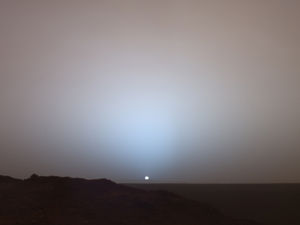Difference between revisions of "Sunlight"
| Line 1: | Line 1: | ||
| − | The [[Sun]] is on average 228 million km away from [[Mars]]. '''Sunlight''' takes 13 minutes to travel from the Sun to Mars with a power of 589 W/m<sup>2</sup>. It is not as bright as on [[Earth]] (1367 W/m<sup>2</sup>). | + | The [[Sun]] is on average 228 million km away from [[Mars]]. '''Sunlight''' takes 13 minutes to travel from the Sun to Mars with a power of 589 W/m<sup>2</sup>. It is not as bright as on [[Earth]] (1367 W/m<sup>2</sup>). |
| + | [[Image:sunset.jpg|thumb|right|300px|Sunset photographed by Mars Rover Spirit]] | ||
| − | [[ | + | from the images transmitted by the various probes and rovers, the sky is caramel colored most of the time. At sunrise and sunset, the sky can be blue near the horizon, as per the Spirit photograph. This is due to |
| + | |||
| + | The Martian [[atmosphere]] does not filter sunlight as efficiently as on Earth, leaving too much UV ray and high energy particles to reach the surface. Life directly on the Martian surface is considered unlikely without additional shielding against UVs and [[cosmic radiation]] from the solar winds. | ||
| − | + | An[[Early warning system for solar radiation|early warning system]]) may be useful for an eventual settlement. | |
The amount of usable energy on the surface is lower due to the rotation of the planet and the angle of the plain. Also, reflection and absorption ([[albedo]]) at the atmosphere must be considered. On Earth the annual usable energy per m<sup>2</sup> is about 1000 kWh in Middle Europe and 2400 kWh in the Sahara. | The amount of usable energy on the surface is lower due to the rotation of the planet and the angle of the plain. Also, reflection and absorption ([[albedo]]) at the atmosphere must be considered. On Earth the annual usable energy per m<sup>2</sup> is about 1000 kWh in Middle Europe and 2400 kWh in the Sahara. | ||
Revision as of 11:13, 13 February 2023
The Sun is on average 228 million km away from Mars. Sunlight takes 13 minutes to travel from the Sun to Mars with a power of 589 W/m2. It is not as bright as on Earth (1367 W/m2).
from the images transmitted by the various probes and rovers, the sky is caramel colored most of the time. At sunrise and sunset, the sky can be blue near the horizon, as per the Spirit photograph. This is due to
The Martian atmosphere does not filter sunlight as efficiently as on Earth, leaving too much UV ray and high energy particles to reach the surface. Life directly on the Martian surface is considered unlikely without additional shielding against UVs and cosmic radiation from the solar winds.
Anearly warning system) may be useful for an eventual settlement.
The amount of usable energy on the surface is lower due to the rotation of the planet and the angle of the plain. Also, reflection and absorption (albedo) at the atmosphere must be considered. On Earth the annual usable energy per m2 is about 1000 kWh in Middle Europe and 2400 kWh in the Sahara.
Sunlight can be used for power generation by solar panels and for growing plants in greenhouses.
Facts and figures
"in the UK we receive an average power of about 125 Wm-2 whilst the Sahara Desert gets 250-300 Wm-2" [1]. With 24*365 hours per year, this results in an average usable energy per m2 and year of 1095 kWh in the UK and 2190-2628 kWh in the Sahara.
The Mars solar constant is 590 W/m3, while the Earth solar constant is 1350 W/m2. Mars gets about half the sunlight Earth does. The Martian atmosphere is dusty; the usable energy at the Mars equator may be about 1100-1300 kWh per year per m2, or somewhat like England or Northern Europe.
Open issues
- What are the psychological and physiological effects of the permanent dim light on humans, animals and plants?
- Can artificial lighting compensate for very long stays?







